Urtopia Carbon Joy Review | Light, Simple, and Lots of Fun
This bike blends elements of a utility e-bike and a cruiser to create a cool, responsive, and highly maneuverable ride with lots of versatility.
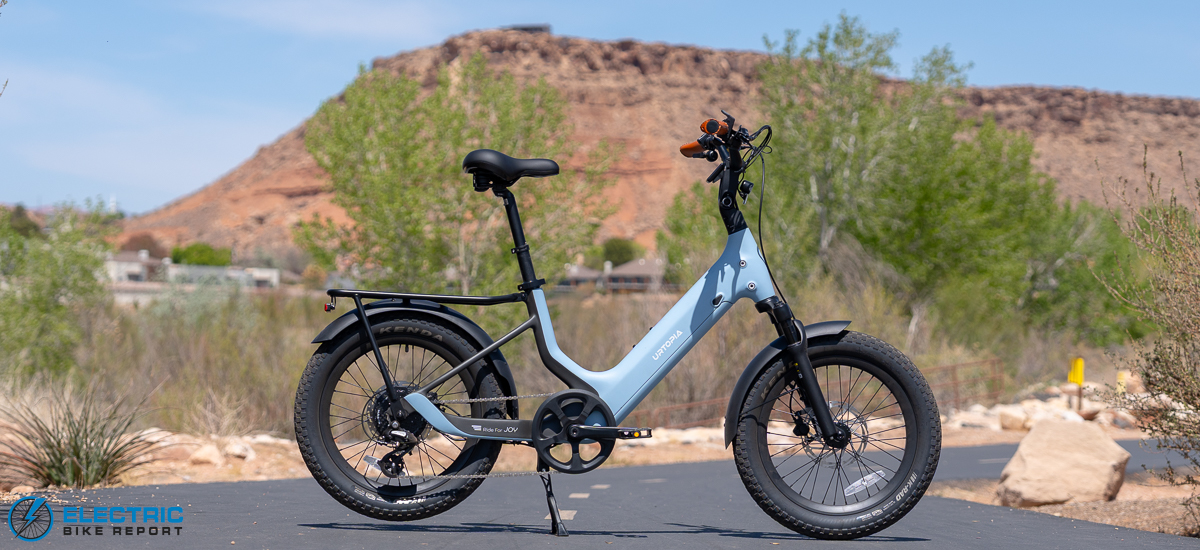
Let’s face it: e-bikes are often large and heavy. Their motors provide a helpful boost to riders looking to reduce strain or ride a little faster than their legs could otherwise move them, but their weight can make them cumbersome and difficult to maneuver.
Urtopia, a maker of carbon fiber e-bikes ranging from the portable, aptly named Carbon Fold 1 to the high-tech, ChatGPT-integrated Carbon 1 Pro, aims to solve the aforementioned problems by utilizing lightweight materials and employing smart design.
We recently had the opportunity to test and review Urtopia’s latest model, the Carbon Joy. This fun-size, multi-purpose cruiser/leisure bike has a responsive ride and a manageable size and weight. It’s also outfitted with a set of curved, cruiser-style handlebars to give the bike a relaxed vibe.
Landing at just under 60 lbs on our scales, including its 5-lb battery, the Carbon Joy is one of the most conveniently-sized bikes of its style that our team has reviewed—and one of the most agile.
One of the first things that stood out to us was the bike’s responsive and natural-feeling pedal-assist system (PAS). Urtopia paired a torque sensor with its lively 500W rear hub motor, allowing its PAS to adapt to the rider’s effort level. This makes the Urtopia feel like a faster and easier version of a non-electric bike—and a true joy to ride (pun intended!).
We found the bike to be quite versatile, thanks to its efficient motor and an accessory package including integrated lights and a cargo rack. With the potential for impressive range, a functional cargo capacity, and a generally comfortable ride, the Carbon Joy can serve as an all-in-one commuter, grocery-getter, and/or leisure bike.
We put the Carbon Joy through our series of standardized performance tests to gauge its speed and programming, its braking power, its climbing ability, and its range. See our full review below to find out how the bike performed and how it compares to similar e-bikes we’ve tested!
Class 2 (throttle to 20 mph)
Class 3 (pedal assist to 28 mph)
 Pros
Pros- The Carbon Joy has extremely fun and nimble handling, thanks to its 20” wheels and lightweight carbon fiber frame.
- It delivers power smoothly and responsively due to its torque sensor, with assist levels ranging from natural to lively.
- The bike is generally approachable and easy to use, with a straightforward interface, modest power levels, and a step-thru frame.
- An overall weight of 59 lbs makes the Carbon Joy easier to lift and transport than many other bikes of this style.
- We found the bike generally comfortable, with ergonomic faux leather grips and a cushy saddle.
- Users can adjust the bike’s speeds to switch between Class 2 and Class 3 settings through the appealing color display.
 Cons
Cons- With relatively low handlebars, even with the adjustable stem at its highest position, we found the bike’s geometry best suited for riders of short to medium height.
- Battery: 36V, 14.7 Ah (529 Wh), Samsung Li-Ion
- Display: VeloFox Color Display
- Motor: 36V, 500W (sustained), 750W (peak), rear hub, 33 Nm
- Headlight: External light, 30 Lux
- Taillights:External taillight w/ brake sensing, rear rack mounted
- Pedal Assist: PAS 1-5
- Claimed Range: Up to 70 Miles
- Throttle:Right hand thumb throttle
- App:N/A
- UL Certification:UL 2271 & UL 2849 Certified
- Claimed weight: 50 lbs w/o accessories
- Tested Weight: 59 lbs
- Rider height range: 4’11” to 6’3”
- Total payload capacity: 330 lbs
- Brakes:Tektro HD-E3520 hydraulic disc brakes with power cut-off sensor, 180mm rotors
- Fenders:Front and rear
- Fork:50mm travel suspension fork with preload adjustment
- Frame: Carbon fiber
- Drivetrain:8-Speed Shimano Altus, 50T chainring, 12-32T cassette
- Grips: PU leather
- Saddle: Comfort saddle
- Handlebar: Aluminum, extender 0-60˚ adjustable, 24˚ backsweep
- Kickstand: Dual leg centerstand
- Pedals: PP platform
- Tires: 20×3” Kenda K-Rad
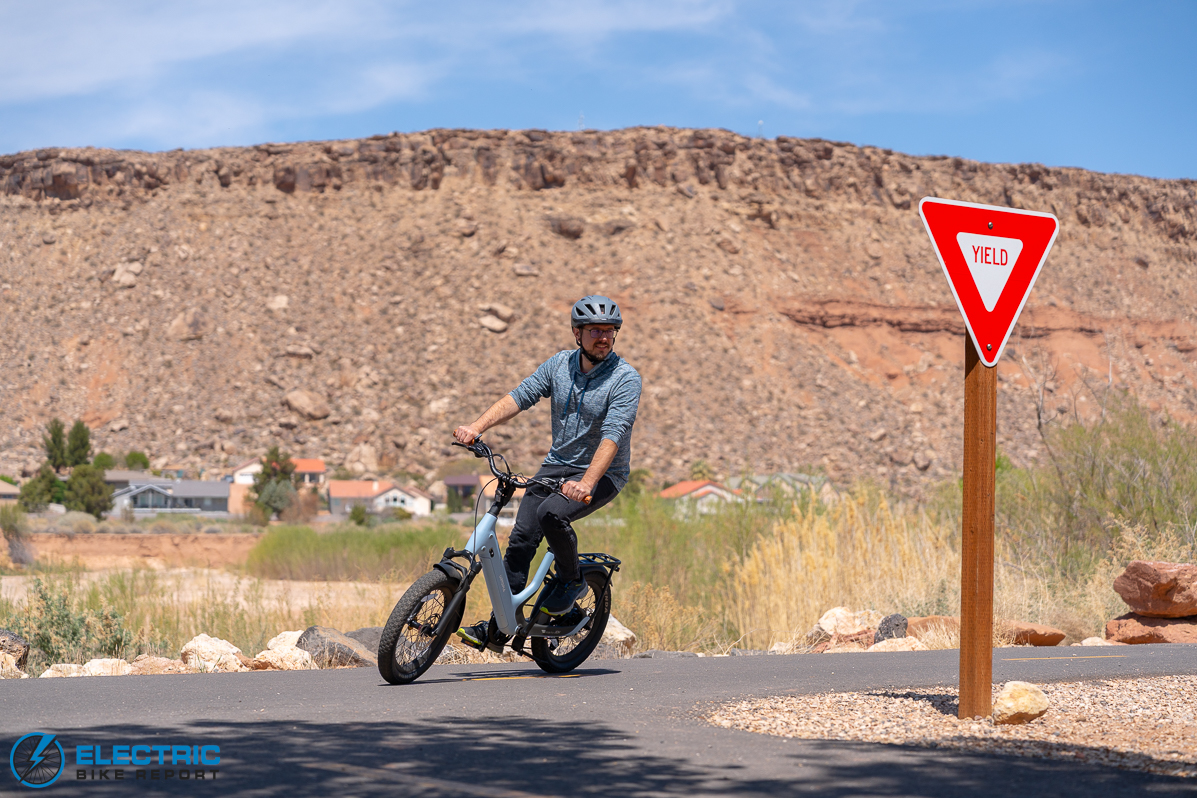
The Carbon Joy’s size and weight give it great handling! It’s quick and simply fun to ride.
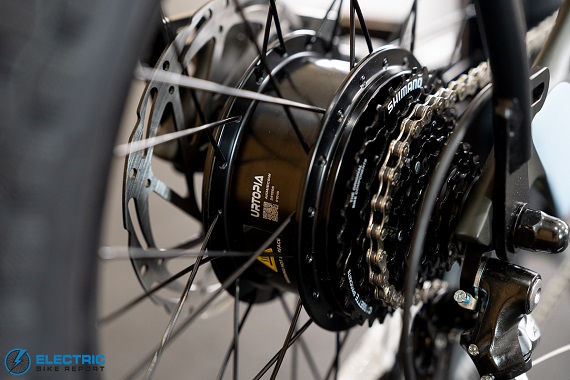
The bike’s 500W rear-hub motor is peppy and responsive; it’s well-suited to the bike’s size and weight.
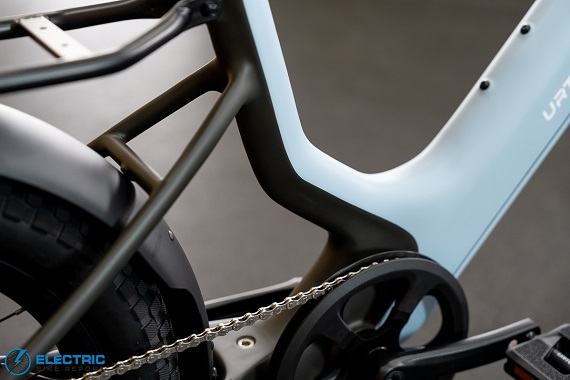
The Carbon Joy’s carbon fiber construction is smooth, seamless, and lightweight. It looks great and has performance benefits, too!
Urtopia Carbon Joy Review: Speed Test
As a Class 2 e-bike, the Carbon Joy has a maximum speed of 20 mph for both its throttle and pedal assist system. Users looking to ride faster can adjust the bike to a Class 3 with faster pedal-assisted speeds; the bike’s marketing materials state a limit of 25 mph, but our testing showed the bike could reach 26-27 mph when unlocked.
I personally tested the bike in each of its pedal assist settings when riding on paved, shared-use paths. I tested its pedal-assisted speeds with both Class 2 and Class 3 settings and recorded my average speed at each of the bike’s four power levels (Eco, Tour, Boost, and Turbo); see above for graphs of my results.
With no pedal assist, the bike pedaled relatively easily, thanks to its lightweight construction. With the PAS activated, both tests started with similar speeds in Eco and Tour modes and then diverged, though both the Class 2 and Class 3 graphs reflect consistent increases in speed/power as I stepped up through the bike’s power levels.
I’ll give Urtopia kudos for programming the bike with such measured increases; this kind of well-balanced programming generally feels intuitive and easy to use. I also appreciated that the lowest assist level delivered an appreciable amount of power to make pedaling noticeably faster and easier.
With more time on the bike, I noticed a cool and unusual feature that requires some explanation. Like many e-bikes with torque sensors, the Carbon Joy relies on a combination of sensors for smooth and consistent power delivery.
I noticed that it seemed to be primarily torque-sensor-based in most of its assist levels, but the highest setting seemed to be more cadence-driven. As such, Eco, Tour, and Boost modes had the highly responsive feel mentioned above, while Turbo mode had a stronger, steadier flow of power that relied less on the amount of pressure I applied. The result was a remarkably low-effort experience suitable for easier travel uphill or when carrying cargo.
Another component of this test focused on the throttle’s acceleration. The Carbon Joy’s throttle picks up gradually in speed, steadily but unhurriedly reaching 20 mph. I found the bike’s acceleration to be broadly approachable and suitable for aging riders and those newer to e-bikes.
Overall, the Carbon Joy’s performance in this test was excellent; I give the bike a well-earned two thumbs up!

As a utility-style e-bike, the Carbon Joy is an all-rounder that can be used for leisure, exercise, errand running, commuting, and more.

An 8-speed Shimano Altus drivetrain provides effective gearing for flats, hills, and Class 3 speeds.
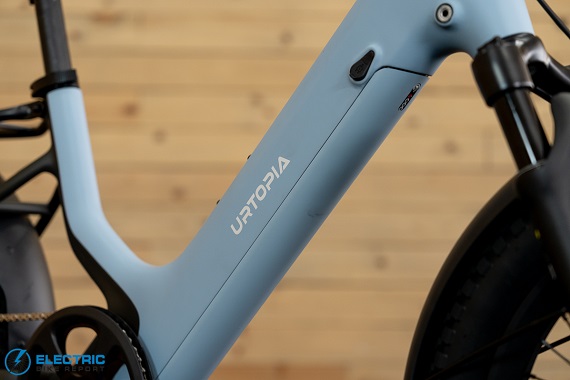
The Carbon Joy’s 529 Wh battery is fully integrated into the underside of its down tube.
Urtopia Carbon Joy Review: Range Test
Using the method explained above, our testers went 24.6 and 74.9 miles in our range tests on a single charge of the Carbon Joy’s 529-Wh battery.
As shown in the graphic above, the bike’s Eco Mode result was significantly above average when compared to similar e-bikes our team has reviewed! Its Turbo Mode test yielded relatively short range in comparison, though this was not unexpected due to the bike’s smaller-than-average battery.
At the time of writing, similar bikes we tested averaged roughly 33 and 59 miles while carrying batteries that averaged 703 Wh. So, while the Carbon Joy’s Turbo Mode test gave us around 8.5 miles less than average, it also had roughly 174 Wh (about 25%) less battery capacity. This makes its Eco Mode test, which went beyond the average by nearly 16 miles, that much more impressive!
In truth, the bike did well for its specs, even in its highest assist level. Based on the bike’s 500W motor and 529 Wh battery, we calculated an estimated 18.4 miles and 64 minutes of ride time for our Turbo mode test. Its real-world results exceeded our expectations by roughly 6 miles and 20 minutes, showing a 34% increase in efficiency that is potentially due to its torque sensor.
We were pleased to note that our real-world results exceeded Urtopia’s advertised range of up to 70 miles, even if only by a few miles. Our tests showed that the brand’s claim was accurate, and also reflected the Carbon Joy’s suitability for taking long rides when commuting or cruising.
Keep in mind that our testing was done with the bike set to Class 2 speeds and without carrying cargo on the rack; users should expect fewer miles when riding faster or carrying extra weight. The bike does include a 4-amp fast charger, so when a recharge is necessary, it should only take a little over 3.5 hours.
Urtopia Carbon Joy Review: Hill Test
We tested a pre-production model of the Carbon Joy that didn’t perform as expected in our Hill Test. Urtopia sent us a new display with updated programming to reflect the performance of the production bike. As such, we’re currently retesting the bike, which has shown significant improvement thus far.
Check back soon for an update about the bike’s climbing performance!
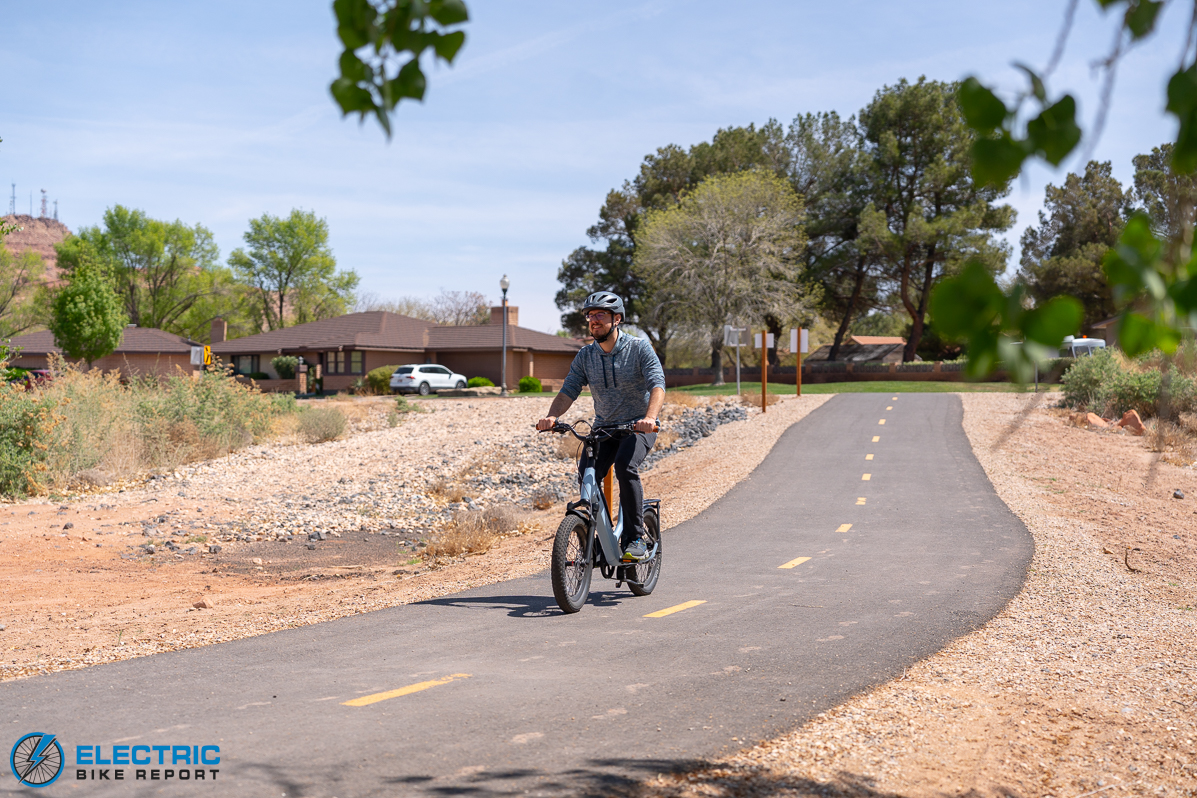
We found the Carbon Joy to be approachable in both its power levels and operation; it’s straightforward, controlled, and easy to ride.
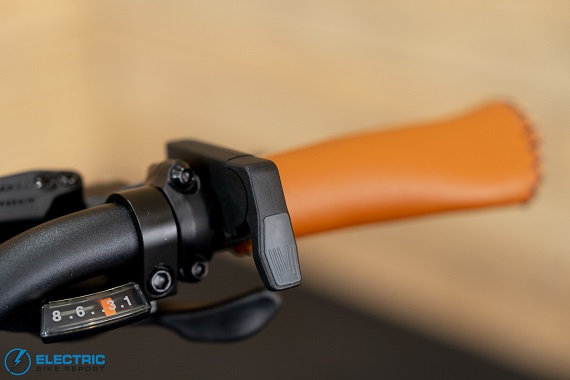
The bike’s throttle lever sits on the right handlebar next to the rapidfire shifter.
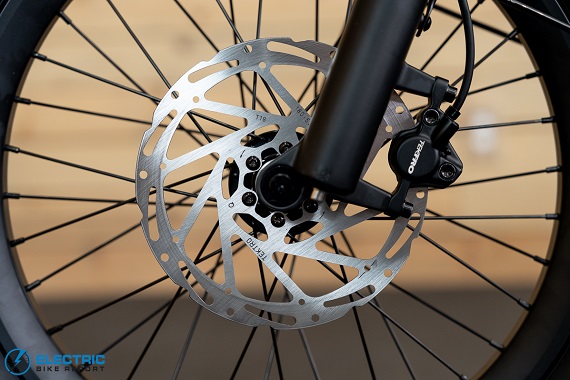
The Tektro HD-E3520 system is tried, tested, and true, giving reliable stopping power.
Urtopia Carbon Joy Review: Brake Test

We tested the Carbon Joy’s Tektro hydraulic disc brake system using the method described above. The bike’s average stopping distance was a remarkably impressive 18’3”, making it one of the best-performing utility e-bikes we’ve put through this test!
For perspective, other bikes in the utility category averaged 20’4” when braking, so the Urtopia’s stopping distance was just over 2 feet shorter than average.
Weight is a major contributing factor to braking performance; typically, the heavier a bike is, the harder it is to slow down. Utility-style e-bikes are often much heavier than the Carbon Joy—the category’s average is 74.8 pounds at the time of writing—making the Urtopia slightly over 15 pounds lighter than average.
As such a (relatively) lightweight e-bike, it makes sense that its stopping distance would also be shorter than average.
In my personal testing of the Carbon Joy, I thought its brakes felt great. The system had a powerful-but-not-too-aggressive stopping force and overall good modulation. Based on its overall feel and performance data, we give the bike an emphatic two thumbs up in this test!
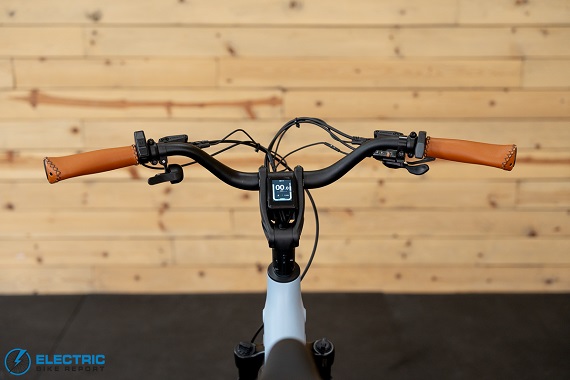
We tested a pre-production model with relatively straight handlebars, but the final version will have curved cruiser-style bars.
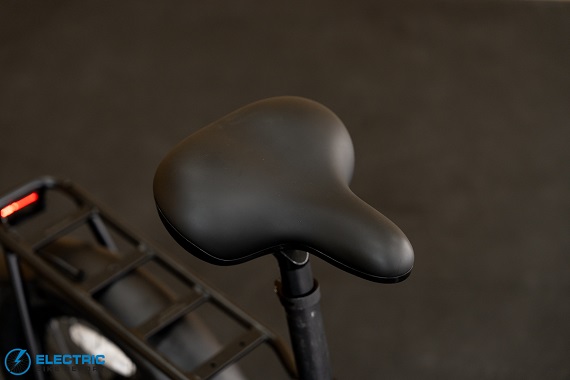
The saddle was cushy and comfortable; the production model will have a brown saddle that better matches its faux leather grips.
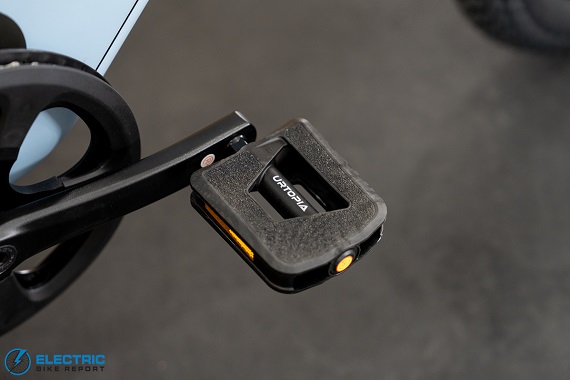
The included pedals with grip tape worked well enough, but we’d have preferred studded pedals to reduce slipping.
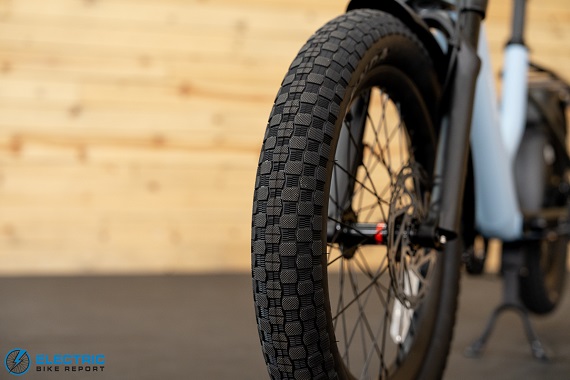
The checkerboard tread pattern on the Kenda K-Rad tires allows for light off-roading with good traction on unpaved surfaces.
Urtopia Carbon Joy Review: Ride Quality
In the intro section of this review, I briefly mentioned the Carbon Joy’s nimble handling and responsive PAS. These factors are core elements of how the bike feels to ride, but they are pieces of a larger whole. In this section, I will discuss many of the bike’s other qualities and address one point of critique.
To expand on the Carbon Joy’s handling, it has an airy and energetic feel when riding that is a natural side effect of its lightweight frame. Combined with small 20” wheels, a relatively short wheelbase, and 3” wide mid-fat tires, it maneuvers quickly and can turn on a dime.
The bike’s pedal assist system responds quickly to changes in pedal pressure while delivering power smoothly; there are no jarring surges or abrupt halts in motor output. As hinted at in our Speed Test section, the bike’s four PAS settings offer an approachable selection of well-balanced power levels with varying degrees of ease.
The Carbon Joy’s carbon fiber frame is made in a single size that Urtopia advertises as suitable for riders from 5’0” to 6’3”. To tailor the bike’s fit, it features an adjustable stem with 60° of rotation to alter the handlebar height and reach. It also has a dual-telescoping seatpost with roughly 10” of saddle height adjustment.
At 5’11”, I found myself splitting the range of adjustment at the stem and seatpost to find a comfortable fit. The extended seatpost had plenty of length to provide full leg extension, but even at its highest point, the adjustable stem placed the handlebars somewhat awkwardly low.
Additionally, the fact that the adjustable stem routes the bike’s cables through the headset means that finding a taller replacement option may be difficult. As such, the Carbon Joy is likely best suited for riders of short to average height.
We tested a pre-production model with a few differences from the final version of the bike. Most notably, the production model will have a softer suspension fork and handlebars with 24° of backsweep instead of a stiffer suspension fork and handlebars with only 15° of backsweep.
Without experiencing the production model’s feel, it’s difficult to comment on the changes. With that in mind, our suspension fork did feel noticeably stiff, so I think there’s a good chance that the final version of the bike will be more comfortable overall.
I liked the feel of the handlebars and saddle (the production model will also have a brown saddle instead of the black one on our test bike). The pedals can be easily replaced, but I would have preferred studded aluminum platforms to the plastic pedals with grip tape that are standard.
Simplicity is another highlight of the Carbon Joy; its cockpit is uncluttered, with only a small control panel, bell, throttle lever, and trigger-style shifter. I found the stem-mounted color display appealing, and I liked that its angle could be easily adjusted for visibility. Its color-coded PAS settings were also a nice touch.
Overall, I think the Carbon Joy’s ride quality is solid despite the bike’s sizing limitations, and I believe it has a lot to offer for those who value agility, responsiveness, and overall ease of use.
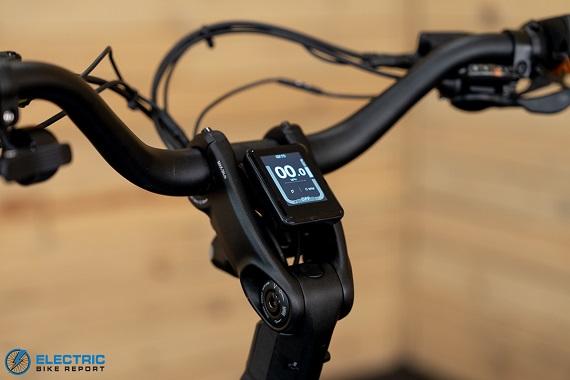
The angle of the stem-mounted color display can be easily adjusted for readability.
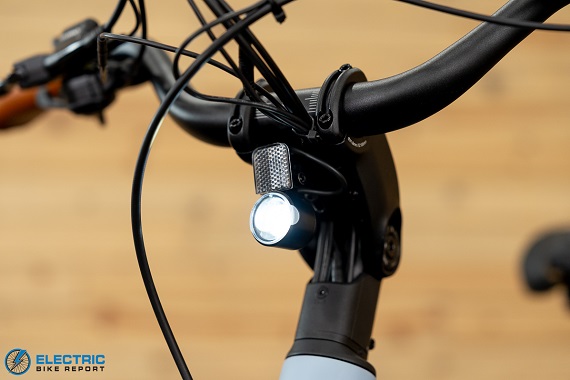
The bike has an integrated light system with a small stem-mounted LED headlight and a taillight with brake light functionality.
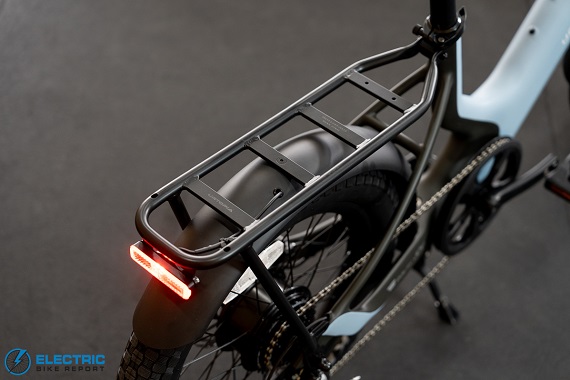
A carrying capacity of up to 59.5 lbs makes it possible to carry a load of groceries or plenty of other types of cargo on the included rack.
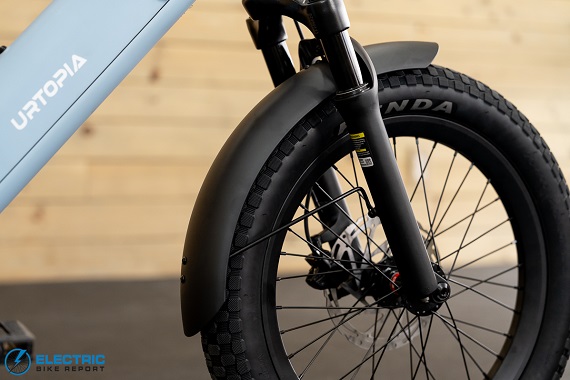
The Carbon Joy’s suspension fork has 50mm of travel to soften bumps and rough pavement.
Urtopia Carbon Joy Review: Summary / Where to Buy
My perspective hasn’t changed now that I’ve had the opportunity to review the Carbon Joy; it’s a versatile and functional cruiser-style e-bike that’s unlike most others we’ve tested. In general, I think Urtopia was successful in creating a lightweight, multipurpose bike suitable for both aging riders and younger folks alike, although the bike is not without its flaws.
The bike generally delivered solid results in our series of performance tests, with its pros largely outweighing its cons. On the list of commendations, it displayed a responsive and intuitive pedal assist system with approachable power levels. It also demonstrated an efficient motor with great range test results and excellent braking power.
We appreciate Carbon Joy’s unique approach as a relatively light and nimble cruiser that provides power responsively and smoothly, delivering more payoff with less effort. With that in mind, we consider it ideal for riders of short to medium height who enjoy the sense of riding a non-electric bike.
To make the bike more approachable and appealing to its intended audience, we encourage Urtopia to increase the torque on the next iteration of the bike. The current version, however, will likely be ideal for riders of short to medium height who prefer the sense of riding a non-electric bike—one that provides more payoff with less effort.
While not as overtly high-tech as some of the company’s other models, the Carbon Joy prioritizes simplicity, functionality, and, most importantly, a fun user experience. It’s not overly complicated, and it doesn’t need to be; like many of the best cargo and utility e-bikes, we think it would make a solid commuter, errand-runner, leisure bike, or a combination of the three!
Happy Riding! Make sure to let us know if you have any questions or if you think we left anything out in this review of the Urtopia Carbon Joy down in our comments section.




I have this bike and am looking for a spare battery. Any suggestions ?
Hi Joseph, have you tried reaching out to Urtopia directly?